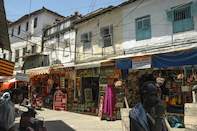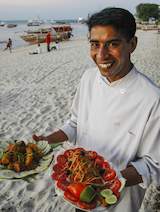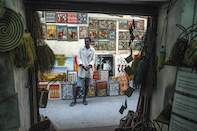
No one single attraction can beat an afternoon strolling through the narrow streets and winding alleys of ancient Stone Town, the capital of Zanzibar. You'll get lost - everybody does - but don't worry, you'll emerge from the cool, shady lanes into the blinding sunlight of the seafront eventually.
Until then, you'll find something of interest around every corner - an Arab archway leading into a white-walled square, with the sound of prayer coming from behind the walls of a mosque. Or perhaps you'll stumble upon the Darajani market, with symmetrical piles of oranges, baskets of spices and enormous chunks of fresh fish arranged under palm-thatch shelters.
Ladies will glide past, shrouded in black Islamic headdresses. Old, long-bearded men in white skull caps will look up from their games of Bao or dominoes to greet you gravely as you pass, and small children will take your hand and invite you to join their games in the overgrown remains of Indian townhouses. Remember to keep looking up - below a blue strip of sky, ornate shutters are thrown open and neighbours lean across the narrow gap between their homes to swap gossip and jokes, hang out washing, or just watch the world go by three storeys below.
Look out for Arabic coffee sellers, strolling along the streets with their charcoal braziers and bronze pots hanging from a yoke across their shoulders. Or porters manoeuvring wheelbarrows almost as wide as the alleyways they're passing through, shouting 'hodi, hodi' ('let me pass'). As evening falls, the seafront comes alive with stalls selling fried fish and chicken on skewers, hurricane lamps illuminating piles of squid and octopus and mounds of chips.
Sugar cane is pressed through an antique mangle and funnelled into glasses - cool, sweet and instantly refreshing. Small boys strip naked and leap off the sea wall into the oily sea, turning pink as the last rays of the sun fade and the muezzin begins his wailing call to evening prayer.
As well as the magic of the streets, Stone Town does have certain historical buildings that are worth a look. The Palace Museum and the Old Fort on the seafront both house collections of furniture and clothing from the days of the Sultans and the Palace Museum has a room dedicated to Princess Salme, daughter of Sultan Said, who eloped with a German businessman in the 19th century.
The Anglican cathedral, built on the site of the old slave market, has a crucifix made from the tree under which the explorer David Livingstone's heart was buried. Nearby are the underground chambers in which slaves were kept, forced to crouch on stone shelves less than two feet high.
Spice Tours
A spice tour is probably the best way of seeing the countryside around Stone Town and meeting rural communities. Guides will take you on a walking tour of the spice farms at Kizimbani or Kindichi, picking bunches of leaves, fruit and twigs from bushes and inviting you to smell or taste them to guess what they are.
Pretty much all the ingredients of the average kitchen spice rack are represented - cinnamon, turmeric, ginger, garlic, chillies, black pepper, nutmeg and vanilla - the list goes on and on. Local children follow you all the way around, making baskets of palm leaves and filling them with flowers to give to you.
At lunchtime, you'll stop in a local house for a meal of spiced pilau rice and curry, followed by sweet Arabic coffee and lemongrass cake. Many spice tours include a visit to the Persian baths built by Sultan Said for his harem, and a stop at Fuji beach just outside Stone Town for a swim on the way back. The average price for a group spice tour is $15, including lunch.
Eating Out in Stone Town

The seafront fish market at Forodhani Gardens, in the middle of Stone Town, is THE place to come for fresh, inexpensive seafood. Skewers of kingfish, prawns and tuna are grilled on makeshift barbecues and served up with piles of salad, chips or naan bread.
The market opens as soon as the first catch of the day is in, just after dark. If you're a veggie, try Zanzibar Pizza - more like an omelette - and wash it all down with freshly pressed sugar cane juice. A steaming plate of fish or lobster will only cost around $3.
Outside Stone Town, no particularly well-known restaurants exist, but the food all across both islands is consistently good and extremely well-priced, with the staples being pilau rice, fish and seafood. Sauces are usually spicy curries, with coconut milk added for flavour.
Fruit abounds on Zanzibar, and banana, pineapple, coconut, jackfruit, mango or papaya follow any meal. Tea and coffee are often flavoured with lemongrass or cinnamon.
Shopping in Stone Town
Zanzibar, and especially Stone Town, is a shopper's paradise. The narrow winding streets are lined with stores selling local crafts, antiques, jewellery, clothes and spices.
The Zanzibar Gallery, on Kenyatta Road, Shangani, sells a huge range of printed fabrics and clothes plus silver jewellery and locally made massage oils and perfumes, as well as a range of handmade bubble baths in glass bottles.
The Gallery is also a publishing company, and sells a range of books on local history, plus coffee table and photographic books, guidebooks, novels, address books, calendars and postcards featuring photographs by the shop's owner, well-known photographer Javed Jafferji. The Gallery Zanzibar also sells batiks, paintings and antiques from all over Africa alongside printed t-shirts and other clothes.
The Orphanage Shop, near the Old Fort, sells crafts and paintings by local artists and the orphans themselves, plus bolts of brightly coloured fabric, which the in-house tailor can make up to your own design.

Two of the best souvenirs to bring home from Zanzibar are: Kangas and Kikois - the brightly patterned fabrics worn by local women and men respectively are used by locals as a matching skirt and head covering, or in the case of men a casual alternative to trousers.
For tourists, they make an excellent souvenir and can be used as a bath towel, beach wrap or sarong. For ideas on how to wear your kanga, along with a few cheeky cartoons, look for the Krazy Kanga Book by Pascal Bogaert, on sale in the Zanzibar Gallery.
Bao games - Bao is played on street corners and in village squares across the whole of East Africa, with regional variations. It consists of a carved wooden board, with rows of largish holes, into which seeds are dropped, functioning as both counters and dice. It's surprisingly easy to pick up and very addictive.
Bao boards come in all shapes and sizes, from small folding ones ideal for rucksacks, to huge, ornate antique boards which double as tables. Be sure to buy some spare seeds at the same time as they have a habit of getting lost.
Zanzibar Chests - Arab-style wooden chests inlaid with brightly polished brass are hand-carved in many workshops in Zanzibar and come in all sizes, from tiny jewellery boxes to enormous trunks.
Beware of buying large polished shells, lumps of coral or tortoiseshell products in Stone Town or on the beach. Their collection and sale is illegal, and many of the species they derive from are already endangered.
Copyright © Gemma Pitcher 2004

 Zanzibar Hotels and Beach Lodges - Known as the legendary Spice Island, the Zanzibar coast of Tanzania epitomizes all that stands for Africa...
Zanzibar Hotels and Beach Lodges - Known as the legendary Spice Island, the Zanzibar coast of Tanzania epitomizes all that stands for Africa...